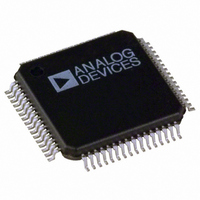AD7606BSTZ-6RL Analog Devices Inc, AD7606BSTZ-6RL Datasheet - Page 21

AD7606BSTZ-6RL
Manufacturer Part Number
AD7606BSTZ-6RL
Description
Simulat Sampliing Bipolar 16 Bit I.C.
Manufacturer
Analog Devices Inc
Type
Data Acquisition System (DAS), ADCr
Datasheet
1.AD7606BSTZ-6.pdf
(36 pages)
Specifications of AD7606BSTZ-6RL
Design Resources
Layout Considerations for an Expandable Multichannel Simultaneous Sampling Data Acquisition System Based on AD7606 (CN0148)
Resolution (bits)
16 b
Sampling Rate (per Second)
200k
Data Interface
DSP, MICROWIRE™, Parallel, QSPI™, Serial, SPI™
Voltage Supply Source
Single Supply
Voltage - Supply
4.75 V ~ 5.25 V
Operating Temperature
-40°C ~ 85°C
Mounting Type
Surface Mount
Package / Case
64-LFQFP
Lead Free Status / RoHS Status
Lead free / RoHS Compliant
Other names
AD7606BSTZ-6RL
Available stocks
Company
Part Number
Manufacturer
Quantity
Price
Company:
Part Number:
AD7606BSTZ-6RL
Manufacturer:
ADI
Quantity:
1 359
Company:
Part Number:
AD7606BSTZ-6RL
Manufacturer:
Analog Devices Inc
Quantity:
10 000
TERMINOLOGY
Integral Nonlinearity
The maximum deviation from a straight line passing through
the endpoints of the ADC transfer function. The endpoints of
the transfer function are zero scale, at ½ LSB below the first
code transition; and full scale, at ½ LSB above the last code
transition.
Differential Nonlinearity
The difference between the measured and the ideal 1 LSB
change between any two adjacent codes in the ADC.
Bipolar Zero Code Error
The deviation of the midscale transition (all 1s to all 0s) from
the ideal, which is 0 V − ½ LSB.
Bipolar Zero Code Error Match
The absolute difference in bipolar zero code error between any
two input channels.
Positive Full-Scale Error
The deviation of the actual last code transition from the ideal
last code transition (10 V − 1½ LSB (9.99954) and 5 V − 1½ LSB
(4.99977)) after bipolar zero code error is adjusted out. The
positive full-scale error includes the contribution from the
internal reference buffer.
Positive Full-Scale Error Match
The absolute difference in positive full-scale error between any
two input channels.
Negative Full-Scale Error
The deviation of the first code transition from the ideal first
code transition (−10 V + ½ LSB (−9.99984) and −5 V + ½ LSB
(−4.99992)) after the bipolar zero code error is adjusted out.
The negative full-scale error includes the contribution from the
internal reference buffer.
Negative Full-Scale Error Match
The absolute difference in negative full-scale error between any
two input channels.
Signal-to-(Noise + Distortion) Ratio
The measured ratio of signal-to-(noise + distortion) at the
output of the ADC. The signal is the rms amplitude of the
fundamental. Noise is the sum of all nonfundamental signals
up to half the sampling frequency (f
The ratio depends on the number of quantization levels in
the digitization process: the more levels, the smaller the
quantization noise.
The theoretical signal-to-(noise + distortion) ratio for an ideal
N-bit converter with a sine wave input is given by
Thus, for a 16-bit converter, the signal-to-(noise + distortion)
is 98 dB.
Signal-to-(Noise + Distortion) = (6.02 N + 1.76) dB
S
/2, excluding dc).
Rev. A | Page 21 of 36
Total Harmonic Distortion (THD)
The ratio of the rms sum of the harmonics to the fundamental.
For the AD7606/AD7606-6/AD7606-4, it is defined as
where:
V
V
harmonics.
Peak Harmonic or Spurious Noise
The ratio of the rms value of the next largest component in the
ADC output spectrum (up to f
of the fundamental. Normally, the value of this specification is
determined by the largest harmonic in the spectrum, but for
ADCs where the harmonics are buried in the noise floor, it is
determined by a noise peak.
Intermodulation Distortion
With inputs consisting of sine waves at two frequencies, fa and fb,
any active device with nonlinearities creates distortion products
at sum and difference frequencies of mfa ± nfb, where m, n = 0,
1, 2, 3. Intermodulation distortion terms are those for which
neither m nor n is equal to 0. For example, the second-order
terms include (fa + fb) and (fa − fb), and the third-order terms
include (2fa + fb), (2fa − fb), (fa + 2fb), and (fa − 2fb).
The calculation of the intermodulation distortion is per the
THD specification, where it is the ratio of the rms sum of the
individual distortion products to the rms amplitude of the sum
of the fundamentals expressed in decibels (dB).
Power Supply Rejection Ratio (PSRR)
Variations in power supply affect the full-scale transition but not
the converter’s linearity. PSR is the maximum change in full-
scale transition point due to a change in power supply voltage
from the nominal value. The PSR ratio (PSRR) is defined as the
ratio of the power in the ADC output at full-scale frequency, f,
to the power of a 100 mV p-p sine wave applied to the ADC’s
V
where:
Pf is equal to the power at Frequency f in the ADC output.
Pf
supply.
Channel-to-Channel Isolation
Channel-to-channel isolation is a measure of the level of crosstalk
between all input channels. It is measured by applying a full-scale
sine wave signal, up to 160 kHz, to all unselected input channels
and then determining the degree to which the signal attenuates
in the selected channel with a 1 kHz sine wave signal applied (see
Figure 28).
1
2
DD
S
is the rms amplitude of the fundamental.
to V
is equal to the power at Frequency f
and V
THD (dB) =
20log
PSRR (dB) = 10 log (Pf/Pf
9
are the rms amplitudes of the second through ninth
SS
supplies of Frequency f
V
2
2
+
AD7606/AD7606-6/AD7606-4
V
3
2
+
V
4
2
+
S
V
/2, excluding dc) to the rms value
S
)
5
2
V
+
1
S
V
.
6
2
S
+
coupled onto the AV
V
7
2
+
V
8
2
+
V
9
2
CC














